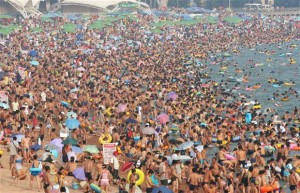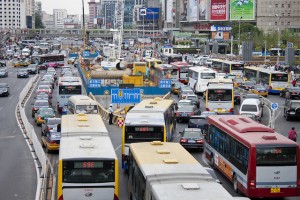 Population of China 2016
Population of China 2016
Based on the total number of births, total number of deaths, net migration rates, and the population of 2015, the current population of the People’s Republic of China is estimated to be about 1,390,510,630. China’s population makes up around 19.3% of the world’s population. The current estimated population indicates a growth of 36,510,630 people or a population growth of 2.7% during 2013. As a result of the current population of China, it remains the most populous country in the entire world. China has about 130 million more people than the second largest country in the world, India. Based on the population and the total area of the country, the population density of China in 2016 is estimated to be about 145 people per square kilometer or 375 people per square mile.
One-Child Policy in China 2016
As a result of the continuously growing population of China, the government enacted a form of population control, officially known as the Family Planning Policy, otherwise known as the One-Child Policy. In 1979, the Chinese government introduced the policy as a response to the growing social, economic, and environmental issues that came due to the high population of the country. The premise of the policy is to discourage (and even sometimes prevent) families from having more than one child. There are some exceptions to the policy, however. If the first child is a girl or is disabled, the family can have another child. Also, if neither parent has siblings, two children are allowed. In fact, as of November 2016, the policy was updated to allow for a family to have two children if one of the parents is an only child. Some controversies surrounding the policy, both in China and throughout the rest of the world, include the increase in forced abortions, female infanticide, and an increased imbalance among the sexes in China.
Education in China 2016
It is required that children in China attend school for at least nine years. The nine years of required schooling is completely free to the students. They start school around the age of six in a primary school system and then move to a junior middle school around age eleven. As of 2011, over 81% of Chinese students continued their education to receive a secondary education degree. In order to enter into a secondary institution, a student must take the Gaokao, which is China’s national university entrance exam. Each province determines the Gaokao, but there are three standard subjects on every test: Chinese, Mathematics, and a foreign language (typically English). Some other common subjects offered are Physics, Chemistry Biology, History, Geography, and Political Education. Also, teachers must go through a significant level of training before actually teaching in the classroom in order to uphold the high standards of education in China.
Health Care in China 2016
Beginning in the 1950s, the Chinese government worked to establish a public health program in order to combat the growing health concerns in the country. Over the years since the 1950s, most of the health care in China became mostly privatized, which, in return, resulted in an increase in the quality of the education as well. In 2009, China invested around $125 billion in a 3-year health care initiative. By 2011, as a result of the initiative, around 95% of the country has health insurance. Also, it has become the world’s third largest supplier of pharmaceuticals. Some health concerns in China include respiratory problems that come as a result of the air pollution, which caused 1.2 million premature deaths in 2010, a high portion of cigarette smokers, and lastly obesity among the youth in the urban parts of China. The average life expectancy in China is about 75 years and infant mortality is 12 infants per 1000 births.
Cuisine in China 2016
There are eight standard culinary traditions throughout the region of China: Anhui, Cantonese, Fujian, Hunan, Jiangsu, Shandong, Szechuan, and Zhejiang. Each style has certain characteristics based on their geographic location and traditions. Anhui cooking derives from the cooking styles of the Huangshan Mountains. It uses a wide variety of herbs and vegetables, especially bamboo and mushrooms. Cantonese is characterized by the idea of “dim sum”, which are small dishes. Many bite-sized portions are prepared to allow the person eating to experience the tastes of many different dishes, including rice rolls, turnip cakes, and stir-fried green vegetables. Another Cantonese style of dining is called “yum cha”, which simply is the combination of dim sum dishes with tea. Fujian’s influence comes from its geographical location near the coast and the mountains. Various slicing techniques and serving the dishes in some sort of soup or broth also characterize the cuisine. Hunan dishes tend to be the hotter and spicier dishes with a variety of ingredients as a result of the agriculture in the region.
Jiangsu cuisine is one of the most popular forms of cuisine in the country. It combines different styles together and is famous across the world. Most of its dishes involve some sort of meat, whether it is duck, seafood, or poultry. Shandong cuisine is quite popular in Northern China. This cuisine is known for its plethora of different techniques used while cooking and its usage of seafood. Szechuan cuisine tends to use a lot of garlic, chili peppers, and peppercorns. Some other frequent ingredients include peanuts, ginger, and sesame. Lastly, Zhejiang cuisine includes four different styles: Hangzhou, Shaoxing, Ningbo, and Shnghai. These dishes tend to be fresh instead of greasy, and the specifics for each styles come from the location of each area.
China One Child Policy
 Transportation in China 2016
Transportation in China 2016
There are a large variety of transportation systems throughout China. China has the largest highway system in the world, totaling around 53,000 miles of highway. China has also become the world’s largest automobile market, even higher than the United States. Despite the number of people that own automobiles, many people, especially in urban areas, own bicycles. In 2012, around 470 million people owned a bicycle. Also, China has a sophisticated and busy railway system, which is owned by the state. In 2010, the system carried around 1.68 billion passengers. China takes pride in its high-speed railway system, which includes the world’s longest high-speed line. Currently, there exists about 10,000 kilometers worth of high-speed line. By 2020, there is expected to be about 16,000 kilometers of high-speed line. Lastly, in 2011, there was approximately 1,910 active commercial aircrafts in China. However, according to Boeing, that number should increase to almost 6,000 by 2031. But, still, about 80% of the airspace in China is limited to military usage.
Other Resources


